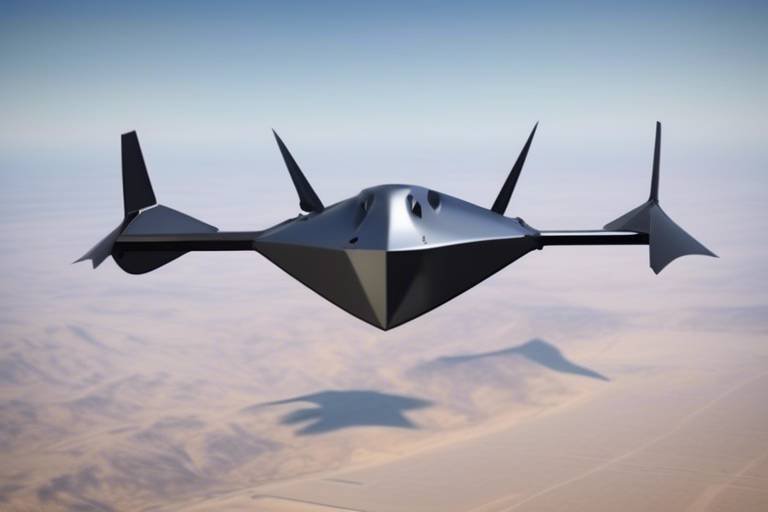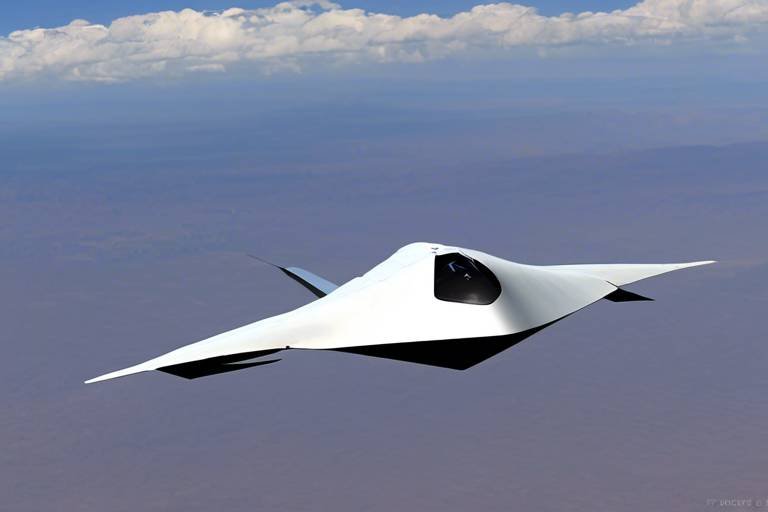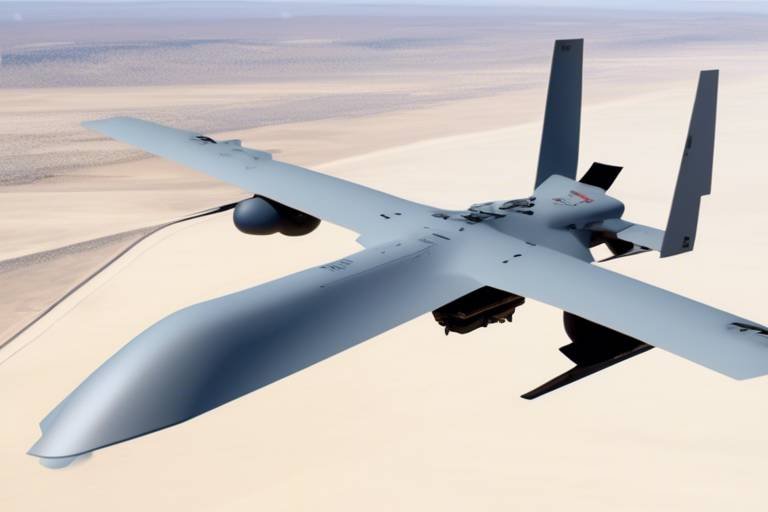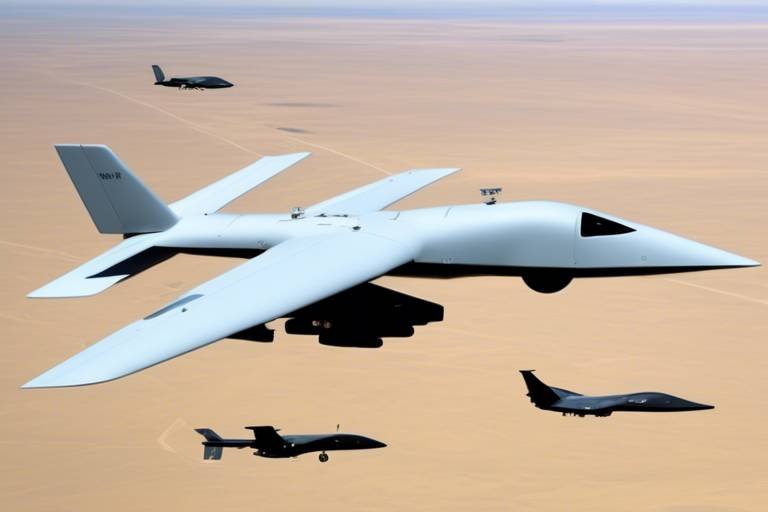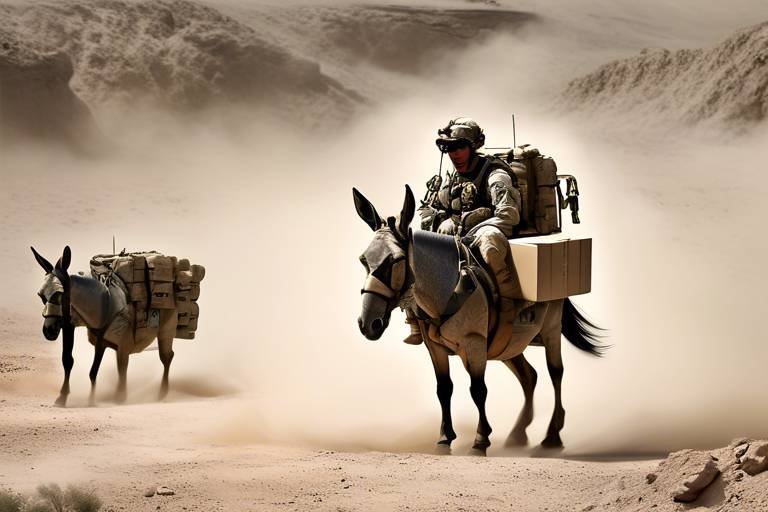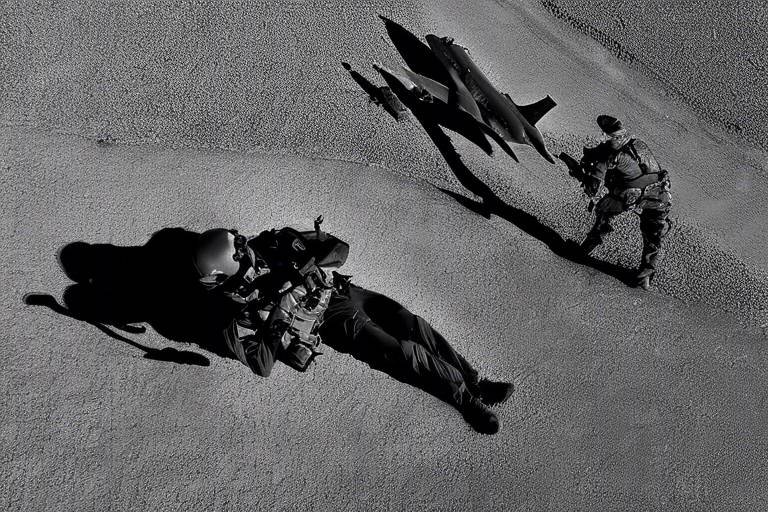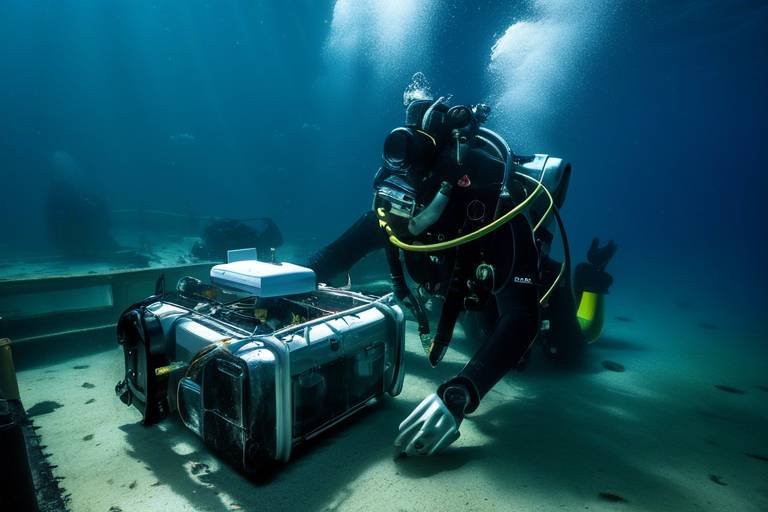How the V-BAT UAV is Revolutionizing Aerial Reconnaissance
In the ever-evolving landscape of aerial technology, the V-BAT UAV stands out as a game changer. This innovative unmanned aerial vehicle (UAV) is not just another drone; it embodies a unique blend of vertical takeoff and landing (VTOL) capabilities with the efficiency of fixed-wing flight. Imagine being able to hover like a helicopter and then glide like an airplane—all in one sleek design! This versatility makes the V-BAT an exceptional choice for reconnaissance missions across various terrains, whether urban jungles or remote wilderness.
The significance of the V-BAT UAV lies in its ability to provide real-time intelligence and situational awareness that was previously unattainable. As we delve deeper into its design and capabilities, you'll discover how this UAV is transforming the way organizations conduct reconnaissance, making operations smoother and more effective than ever before. With its modular design, advanced sensor integration, and impressive endurance, the V-BAT is not just keeping pace with technological advancements; it is setting the standard.
But what exactly makes the V-BAT UAV so special? Let’s explore the standout features that enhance its operational effectiveness, ensuring it meets the diverse needs of military and civilian applications alike. From disaster response to environmental monitoring, the V-BAT UAV is proving to be a versatile tool, capable of adapting to various missions with ease.
- What is the V-BAT UAV? - The V-BAT UAV is an unmanned aerial vehicle designed for vertical takeoff and landing, combining the best of both helicopter and airplane technology.
- What are the primary applications of the V-BAT UAV? - It is used in military reconnaissance, disaster response, environmental monitoring, and infrastructure inspection.
- How does the V-BAT UAV enhance data collection? - It provides real-time aerial imagery and analytics, allowing for informed decision-making based on accurate and timely information.
- What future developments can we expect for the V-BAT UAV? - Continued advancements in technology will likely lead to enhanced capabilities and expanded applications in both military and civilian sectors.

1. Introduction to the V-BAT UAV
The V-BAT UAV is not just another drone; it’s a game-changer in the world of aerial reconnaissance. Imagine a vehicle that can take off and land vertically like a helicopter but flies with the efficiency of a fixed-wing aircraft. This unique combination makes the V-BAT incredibly versatile, allowing it to operate in a variety of environments—from dense urban landscapes to remote wilderness areas. Its design is not only innovative but also addresses many of the challenges faced by traditional UAVs in reconnaissance missions.
What sets the V-BAT apart? For starters, its ability to transition seamlessly between vertical and horizontal flight means that it can be deployed quickly and efficiently, without the need for extensive launch or recovery equipment. This feature is particularly beneficial in situations where time is of the essence, such as disaster response or military operations. The V-BAT can rapidly gather intelligence, providing crucial data that can influence decision-making and operational strategies.
Moreover, the V-BAT UAV is built with a focus on modularity. This means that it can be easily customized for different missions, whether the objective is surveillance, reconnaissance, or data collection. Operators can swap out payloads and sensors based on the specific requirements of their mission, enhancing the UAV's functionality and effectiveness. This adaptability is a significant advantage, allowing it to serve multiple roles across various fields.
In summary, the V-BAT UAV represents a significant leap forward in aerial reconnaissance technology. With its unique design, versatile capabilities, and emphasis on rapid deployment, it stands ready to meet the challenges of modern reconnaissance missions, making it an invaluable tool for both military and civilian applications.

2. Key Features of the V-BAT UAV
The V-BAT UAV stands out in the realm of unmanned aerial vehicles due to its remarkable features that enhance its operational effectiveness in reconnaissance tasks. One of its most notable attributes is its modular design, which allows for easy customization and rapid deployment. This means that depending on the mission requirements, operators can quickly swap out different payloads or sensors, making the V-BAT adaptable to various environments and situations. Imagine being able to transform your UAV from a surveillance tool into a data collection powerhouse with just a few adjustments—this is the kind of flexibility the V-BAT offers.
Another key feature is its long endurance capabilities. Unlike traditional UAVs that may require frequent recharging or refueling, the V-BAT can stay airborne for extended periods, allowing it to cover vast areas without interruption. This is particularly crucial in reconnaissance missions where every second counts, and the ability to gather intelligence over a wide area can make all the difference in operational success.
Moreover, the V-BAT UAV is equipped with advanced sensor integration. This technology enables it to capture high-resolution imagery and collect real-time data, which is vital for decision-making during missions. The data gathered can be analyzed on-the-fly, providing operators with immediate insights that can influence tactical choices on the ground. For instance, if a military unit needs to assess enemy positions or monitor environmental changes, the V-BAT can deliver this intelligence swiftly and accurately.
To summarize, the key features of the V-BAT UAV include:
- Modular Design: Facilitates customization for different missions.
- Long Endurance: Capable of extended flight times for comprehensive coverage.
- Advanced Sensor Integration: Offers high-resolution imaging and real-time data collection.
These features not only enhance the V-BAT's effectiveness in military reconnaissance but also open doors for its use in various civilian applications, showcasing its versatility. As we delve deeper into its applications in the following sections, the significance of these features will become even more apparent.
- What is the maximum flight time of the V-BAT UAV? The V-BAT UAV boasts an impressive flight time, often exceeding several hours depending on payload and environmental conditions.
- Can the V-BAT UAV be used in adverse weather conditions? Yes, the V-BAT UAV is designed to operate in a variety of weather conditions, enhancing its utility in diverse environments.
- What types of sensors can be integrated with the V-BAT UAV? The modular design allows for a wide range of sensors, including electro-optical, infrared, and even specialized payloads for specific missions.

3. Modular Design Advantages
The modular design of the V-BAT UAV is one of its most compelling features, setting it apart from traditional unmanned aerial vehicles. Imagine a vehicle that can be easily tailored to meet the specific needs of a mission, much like a Swiss Army knife that adapts to any situation. This adaptability is not just a convenience; it’s a game-changer in the world of aerial reconnaissance. The V-BAT’s modularity allows operators to swap out components quickly, enabling rapid deployment without the need for extensive downtime or complicated logistics.
One of the standout benefits of this design is its ability to accommodate a variety of payloads. Whether it’s high-resolution cameras, thermal imaging devices, or advanced communication systems, the V-BAT can be outfitted with the necessary equipment to gather the required intelligence. This flexibility means that a single drone can be used for multiple missions, reducing the need for a fleet of specialized UAVs. As a result, organizations can save on costs and streamline operations, all while maintaining high operational effectiveness.
Additionally, the modular design enhances maintenance efficiency. When a component wears out or needs upgrading, it can be replaced without requiring a complete overhaul of the UAV. This not only extends the lifespan of the aircraft but also ensures that it remains at the cutting edge of technology. For instance, if a new sensor becomes available, operators can simply integrate it into the existing framework rather than purchasing a new drone entirely.
Moreover, the V-BAT’s modularity supports customization based on mission type and environmental conditions. For example, in a disaster response scenario, the UAV can be equipped with sensors that detect hazardous materials, while in a military reconnaissance mission, it might carry advanced surveillance equipment. This level of customization ensures that the UAV is always equipped to handle the specific challenges of each operation.
To summarize, the modular design of the V-BAT UAV offers several advantages:
- Rapid Deployment: Quick assembly and disassembly for immediate use.
- Versatile Payload Options: Ability to carry different sensors and equipment.
- Maintenance Efficiency: Easy replacement of parts reduces downtime.
- Customizable Missions: Tailored configurations for specific operational needs.
In conclusion, the modular design of the V-BAT UAV not only enhances its operational capabilities but also ensures that it remains a versatile tool in the ever-evolving landscape of aerial reconnaissance. As technology continues to advance, the importance of such adaptable systems will only increase, making the V-BAT a key player in both military and civilian applications.
Q: What makes the V-BAT UAV's modular design unique?
A: Its ability to quickly swap out components for different missions allows for rapid customization and deployment, making it highly versatile.
Q: Can the V-BAT UAV be used for both military and civilian applications?
A: Yes, the V-BAT UAV is designed to serve various sectors, including military reconnaissance, disaster response, and infrastructure inspection.
Q: How does the modular design affect maintenance?
A: The modular design allows for easy replacement of components, which minimizes downtime and extends the UAV's lifespan.
Q: What types of payloads can the V-BAT UAV carry?
A: The V-BAT can carry a range of payloads, including high-resolution cameras, thermal sensors, and communication devices, depending on the mission requirements.

4. Sensor Integration
The V-BAT UAV stands out in the realm of aerial reconnaissance primarily due to its advanced sensor integration. Imagine having a bird's-eye view of the world, equipped with the latest technology to capture every detail! This UAV is not just flying around; it’s a sophisticated platform that gathers critical intelligence with pinpoint accuracy. The integration of high-resolution cameras, thermal imaging sensors, and various data collection tools transforms the V-BAT into a powerhouse of information gathering.
One of the remarkable aspects of the V-BAT UAV's sensor integration is its ability to operate in diverse environmental conditions. Whether it’s a bright sunny day or a foggy evening, the UAV can adapt thanks to its array of sensors. For instance, the electro-optical sensors provide clear images during daylight, while the infrared sensors excel in low-light situations, ensuring that no detail goes unnoticed.
Moreover, the real-time data transmission capability of the V-BAT UAV allows operators to receive immediate feedback and make informed decisions on the fly. This is especially crucial in military operations where every second counts. The data collected can be analyzed and relayed to command centers, enhancing situational awareness and operational effectiveness. To put it simply, it’s like having a highly skilled scout in the sky, constantly feeding back information.
In terms of data processing, the V-BAT UAV utilizes advanced algorithms to analyze the collected data. This includes image processing techniques that can automatically detect changes in the environment, track movements, and even identify potential threats. The combination of hardware and software makes the V-BAT not just a flying machine, but a smart aerial reconnaissance platform.
Here’s a quick overview of the key sensors integrated into the V-BAT UAV:
| Sensor Type | Functionality | Operational Advantage |
|---|---|---|
| Electro-Optical Camera | High-resolution imaging | Effective during daylight operations |
| Infrared Sensor | Thermal imaging | Operational in low-light conditions |
| LiDAR | 3D mapping and terrain analysis | Precise topographical data |
| Multispectral Sensors | Environmental monitoring | Assess vegetation health and land use |
In conclusion, the sensor integration of the V-BAT UAV is a game-changer in aerial reconnaissance. With its ability to provide real-time, high-quality data across various conditions, it enhances the decision-making process for military and civilian applications alike. As technology continues to evolve, we can only expect these sensors to become even more advanced, pushing the boundaries of what is possible in aerial reconnaissance.
- What types of sensors are used in the V-BAT UAV? The V-BAT UAV employs electro-optical cameras, infrared sensors, LiDAR, and multispectral sensors for a comprehensive data collection experience.
- How does the V-BAT UAV transmit data? The UAV is equipped with real-time data transmission capabilities, allowing operators to receive immediate feedback during missions.
- Can the V-BAT UAV operate in adverse weather conditions? Yes, the advanced sensor integration allows it to operate effectively in various environmental conditions, including low-light and adverse weather.
- What are the military applications of the V-BAT UAV's sensors? The sensors enhance situational awareness, intelligence gathering, and real-time decision-making during military operations.

5. Endurance and Range
The V-BAT UAV stands out in the realm of unmanned aerial vehicles, particularly when it comes to its endurance and range. Imagine being able to survey vast landscapes without the constant worry of needing to recharge or refuel. This capability is not just a minor enhancement; it’s a game-changer for reconnaissance missions. With its impressive flight endurance, the V-BAT can operate for extended periods, allowing it to cover large areas that traditional UAVs might struggle with.
What makes this endurance truly remarkable is the combination of its advanced propulsion system and aerodynamic design. The V-BAT can stay airborne for up to 12 hours, depending on the mission profile and payload. This extended flight time is crucial for operations where time is of the essence, such as in military reconnaissance or disaster response scenarios. Think of it as having a bird’s-eye view that doesn’t have to come down for a pit stop!
Moreover, the range of the V-BAT UAV is equally impressive. It can operate effectively at distances of over 100 kilometers from its launch point, making it suitable for both localized and expansive reconnaissance missions. This capability allows operators to gather intelligence from remote areas without putting themselves in harm's way. The ability to maintain communication and control over such distances is supported by its robust communication systems, which ensure that data can be transmitted back to the base in real-time.
To put this into perspective, let’s consider a few key specifications:
| Feature | Specification |
|---|---|
| Endurance | Up to 12 hours |
| Operational Range | Over 100 km |
| Payload Capacity | Up to 5 kg |
This combination of endurance and range not only enhances the operational capabilities of the V-BAT UAV but also provides significant tactical advantages. For instance, in military operations, having a UAV that can remain in the air for long periods allows for continuous surveillance, which is vital for situational awareness. In civilian applications, such as environmental monitoring or disaster assessment, the ability to cover large areas without interruption can lead to quicker responses and more effective management of resources.
In conclusion, the V-BAT UAV's endurance and range capabilities make it an invaluable tool in the field of aerial reconnaissance. Whether it’s gathering intelligence for military operations or monitoring environmental changes, its ability to stay airborne for extended periods and operate over long distances ensures that it can meet the demands of various missions with efficiency and effectiveness.
- How long can the V-BAT UAV stay in the air? The V-BAT UAV can operate for up to 12 hours, depending on the mission profile.
- What is the maximum operational range of the V-BAT UAV? It can effectively operate over distances of more than 100 kilometers from its launch point.
- What is the payload capacity of the V-BAT UAV? The UAV can carry a payload of up to 5 kg, allowing for various sensor integrations.

6. Applications in Military Reconnaissance
The V-BAT UAV is a game changer in the realm of military reconnaissance, revolutionizing how armed forces gather intelligence and maintain situational awareness. Its unique design, which merges vertical takeoff and landing (VTOL) capabilities with the efficiency of a fixed-wing aircraft, enables it to operate in a variety of challenging environments. Imagine a bird that can hover like a hummingbird yet soar like an eagle—this is essentially what the V-BAT UAV offers to military operations.
One of the standout features of the V-BAT UAV is its ability to conduct surveillance in areas that are difficult to access. Whether it’s dense urban landscapes or rugged terrains, this UAV can maneuver with ease, capturing high-resolution images and streaming video in real-time. This capability is crucial for military operations, where obtaining accurate information can mean the difference between success and failure. The V-BAT UAV provides commanders with a bird's-eye view of the battlefield, allowing them to make informed decisions swiftly.
Moreover, the V-BAT UAV significantly enhances reconnaissance missions through its advanced sensor integration. Equipped with cutting-edge imaging technology, it can detect movement, identify targets, and even monitor environmental changes. The data collected can be utilized for various purposes, including:
- Intelligence Gathering: The UAV can collect vital information about enemy positions and movements, giving military strategists a tactical advantage.
- Surveillance: Continuous monitoring of a designated area ensures that any unusual activities are reported in real-time, allowing for rapid response.
- Damage Assessment: After an engagement, the UAV can be deployed to assess damage and gather information on the effectiveness of military operations.
In addition to its surveillance capabilities, the V-BAT UAV can also support joint operations by providing communication relay services. This feature is particularly beneficial in scenarios where traditional communication lines may be compromised or non-existent. By acting as a mobile communication hub, the V-BAT ensures that troops on the ground remain connected to command units, streamlining operations and enhancing coordination.
The V-BAT UAV's endurance and range further amplify its effectiveness in military reconnaissance. With the ability to fly for extended periods, it can cover vast areas without needing to return for frequent recharges. This capability allows military forces to maintain persistent surveillance over critical regions, ensuring that they have the latest intelligence at their fingertips. Imagine having a watchful eye that never blinks—this is the kind of advantage the V-BAT provides.
As the military landscape continues to evolve, the applications of the V-BAT UAV are likely to expand further. Its versatility means it can be adapted for various missions, from tactical reconnaissance to strategic intelligence operations. In a world where information is power, the V-BAT UAV serves as a vital tool for modern military forces, helping them stay one step ahead of potential threats.
- What makes the V-BAT UAV different from other drones? The V-BAT combines vertical takeoff and landing with fixed-wing efficiency, allowing it to operate in various environments and cover large areas without frequent recharging.
- How does the V-BAT UAV enhance military operations? It provides real-time surveillance, intelligence gathering, and communication relay services, significantly improving situational awareness on the battlefield.
- Can the V-BAT UAV be used in civilian applications? Yes, beyond military use, it is also employed in disaster response, environmental monitoring, and infrastructure inspection.

7. Civilian Applications of the V-BAT UAV
The V-BAT UAV is not just a marvel of engineering for military applications; it has also made significant strides in the civilian sector. This innovative unmanned aerial vehicle is being utilized in various fields, showcasing its versatility and efficiency in addressing real-world challenges. Imagine a tool that can soar above disaster zones, gather critical data, and deliver insights in real-time. That’s exactly what the V-BAT UAV offers! Its unique combination of vertical takeoff and landing (VTOL) capabilities with fixed-wing flight efficiency means it can operate in a range of environments, from urban areas to remote landscapes.
One of the most impactful civilian applications of the V-BAT UAV is in disaster response. When natural disasters strike, time is of the essence. The V-BAT can be deployed quickly to assess damage, locate survivors, and provide essential information to rescue teams. This capability not only speeds up the response time but also enhances the safety of personnel on the ground. For example, during hurricanes or earthquakes, the V-BAT UAV can fly over affected areas, capturing high-resolution images that help in mapping out the extent of the disaster.
Another area where the V-BAT UAV shines is in environmental monitoring. With growing concerns about climate change and habitat destruction, having accurate data is crucial. The UAV can conduct aerial surveys of forests, rivers, and wildlife habitats, providing valuable insights into ecological changes over time. Its advanced sensors can detect changes in vegetation, water levels, and even wildlife populations. This data is not just numbers; it tells a story about our planet and helps conservationists make informed decisions.
Infrastructure inspection is yet another field benefiting from the V-BAT UAV. Traditional methods of inspecting bridges, power lines, and pipelines can be time-consuming and dangerous. The V-BAT can fly over these structures, capturing detailed images and data without putting human inspectors at risk. This not only saves time but also reduces costs associated with manual inspections. Imagine a world where maintenance schedules are optimized based on real-time data collected from the sky!
To summarize, the V-BAT UAV is revolutionizing civilian applications in multiple ways:
- Disaster Response: Rapid deployment for damage assessment and rescue operations.
- Environmental Monitoring: Aerial surveys for ecological data collection and analysis.
- Infrastructure Inspection: Safe and efficient inspections of critical structures.
As we look to the future, the potential applications of the V-BAT UAV in civilian sectors are virtually limitless. With ongoing advancements in technology, we can expect to see even more innovative uses for this remarkable UAV, making it an invaluable asset in our ever-evolving world.
- What makes the V-BAT UAV suitable for civilian use?
The V-BAT UAV's VTOL capabilities combined with its fixed-wing efficiency allow it to operate in diverse environments, making it ideal for various civilian applications. - How does the V-BAT UAV contribute to disaster response?
It provides rapid aerial assessments of disaster zones, helping rescue teams locate survivors and assess damage quickly. - Can the V-BAT UAV be used for environmental studies?
Yes, it can conduct aerial surveys to monitor ecological changes, contributing valuable data for conservation efforts. - Is the V-BAT UAV safe for infrastructure inspections?
Absolutely! It allows for safe and efficient inspections of critical structures without putting human inspectors at risk.

8. Impact on Data Collection
The V-BAT UAV is not just a marvel of engineering; it is a game-changer in the realm of data collection. Imagine having an eye in the sky that can capture high-resolution images and gather real-time data from areas that are otherwise difficult to access. This capability is particularly crucial in today's fast-paced world where timely information can mean the difference between success and failure in various operations. The V-BAT UAV's advanced sensor suite allows it to collect a wide range of data, including thermal imaging, multispectral analysis, and even LiDAR mapping, all while flying at altitudes that provide optimal visibility.
One of the most significant impacts of the V-BAT UAV on data collection is its ability to facilitate informed decision-making. Organizations can rely on the real-time analytics it provides to make quick yet informed choices, whether in military operations or civilian applications. For example, during a natural disaster, the V-BAT can survey affected areas, providing emergency responders with critical information about damage and accessibility. This capability not only accelerates response times but also enhances the effectiveness of the operations being conducted.
Furthermore, the V-BAT UAV's data collection capabilities extend beyond immediate reconnaissance. The data gathered can be analyzed and stored for future reference, creating a valuable repository of information that can be utilized for long-term planning and strategy development. For instance, environmental agencies can monitor changes in ecosystems or urban development over time, allowing them to make data-driven decisions that align with sustainability goals.
To illustrate the impact of the V-BAT UAV on data collection, consider the following table that outlines its key capabilities:
| Capability | Description |
|---|---|
| High-Resolution Imaging | Captures detailed images for accurate analysis. |
| Real-Time Data Transmission | Allows instant access to collected data for immediate decision-making. |
| Multispectral Analysis | Enables the assessment of various environmental factors. |
| Thermal Imaging | Identifies heat signatures, useful for search and rescue operations. |
| LiDAR Mapping | Provides precise topographical data for infrastructure planning. |
In summary, the V-BAT UAV is redefining how data is collected across various sectors. Its ability to gather and analyze data in real-time not only enhances operational efficiency but also ensures that organizations can respond to challenges with agility and precision. As we continue to embrace technology, the role of the V-BAT UAV in data collection will undoubtedly become more prominent, paving the way for innovations that we have yet to imagine.
- What types of data can the V-BAT UAV collect? The V-BAT UAV can collect various types of data, including high-resolution images, thermal imaging, multispectral data, and LiDAR mapping.
- How does real-time data transmission work? The UAV is equipped with advanced communication systems that allow it to transmit data instantly to ground control, enabling immediate analysis and decision-making.
- In what sectors is the V-BAT UAV used? The V-BAT UAV is used in both military and civilian sectors, including disaster response, environmental monitoring, and infrastructure inspection.
- Can the data collected be stored for future use? Yes, the data collected by the V-BAT UAV can be stored and analyzed later, providing valuable insights for long-term planning.

9. Future Developments and Innovations
The future of the V-BAT UAV is not just bright; it's positively dazzling! As technology leaps forward at an astonishing rate, the V-BAT UAV is set to evolve in ways that will redefine aerial reconnaissance. Imagine a world where drones are equipped with even more sophisticated sensors, artificial intelligence, and machine learning capabilities. These advancements will not only enhance the UAV's operational efficiency but also its decision-making abilities in real-time scenarios.
One of the most exciting prospects is the integration of autonomous flight capabilities. This means that the V-BAT could potentially operate without constant human oversight, allowing it to conduct missions in hostile or remote environments where human presence is risky. Envision a scenario where the UAV can autonomously navigate through challenging terrains, avoiding obstacles and making split-second decisions based on its programming and sensory input. This level of autonomy could revolutionize how reconnaissance missions are conducted, making them safer and more efficient.
Moreover, the V-BAT UAV is likely to see advancements in communication technologies. With the implementation of advanced data-link systems, the UAV could transmit high-resolution imagery and data back to its operators in real-time, even in locations with poor connectivity. This would ensure that decision-makers have access to critical information when they need it most, enhancing situational awareness and response times.
Another area ripe for innovation is the battery technology that powers the V-BAT UAV. As we move towards more sustainable energy solutions, improvements in battery life and charging efficiency could significantly extend the operational time of these UAVs. Imagine a V-BAT that can fly for hours on end without needing to recharge, covering vast areas and collecting data over extended periods. This would be a game-changer for both military and civilian applications, allowing for more comprehensive reconnaissance missions.
Furthermore, the potential for collaboration with other UAVs is on the horizon. Future V-BAT models could be designed to work in tandem with swarms of other drones, sharing data and coordinating actions to cover larger areas more effectively. This concept of swarm intelligence could enhance reconnaissance capabilities, enabling the collection of vast amounts of data from multiple perspectives simultaneously.
In terms of applications, the V-BAT UAV is expected to expand its role beyond traditional reconnaissance. With the ability to adapt its payload and sensor suite, it could be utilized for various missions, including search and rescue operations, environmental monitoring, and even agricultural assessments. The possibilities are virtually limitless, and as industries recognize the versatility of the V-BAT, we can expect to see it become a staple in various sectors.
In summary, the future developments and innovations surrounding the V-BAT UAV promise to enhance its capabilities significantly. With advancements in technology, we can anticipate a more autonomous, efficient, and versatile UAV that will not only transform aerial reconnaissance but also open new avenues for its application across multiple fields. The sky is truly the limit!
- What is the V-BAT UAV?
The V-BAT UAV is an unmanned aerial vehicle designed for both vertical takeoff and landing, as well as fixed-wing flight, making it ideal for reconnaissance missions. - How does the modular design of the V-BAT UAV benefit its operation?
The modular design allows for easy customization and rapid deployment, making it adaptable for various missions and operational requirements. - What types of sensors are integrated into the V-BAT UAV?
The V-BAT UAV can be equipped with advanced sensors for high-resolution imaging and real-time data collection, enhancing its reconnaissance capabilities. - What are the potential future applications for the V-BAT UAV?
Future applications may include search and rescue operations, environmental monitoring, and agricultural assessments, showcasing its versatility.
Frequently Asked Questions
-
What makes the V-BAT UAV unique compared to other drones?
The V-BAT UAV stands out due to its combination of vertical takeoff and landing (VTOL) capabilities along with fixed-wing efficiency. This unique design allows it to operate effectively in various environments, making it particularly suitable for reconnaissance missions where flexibility and adaptability are crucial.
-
How does the modular design of the V-BAT UAV benefit its operations?
The modular design of the V-BAT UAV allows for easy customization and rapid deployment. This means that it can be quickly adapted for different missions, whether military or civilian, ensuring that it meets diverse operational requirements efficiently. Imagine being able to swap out components like changing outfits for different occasions!
-
What types of sensors are integrated into the V-BAT UAV?
The V-BAT UAV features advanced sensor integration that includes high-resolution cameras and real-time data collection tools. These sensors provide critical intelligence, enhancing decision-making during reconnaissance missions. It's like having a pair of superhuman eyes in the sky, gathering vital information that would otherwise be difficult to obtain.
-
What is the endurance and range of the V-BAT UAV?
The V-BAT UAV boasts impressive endurance and range capabilities, allowing it to cover vast areas without the need for frequent recharging. This makes it an invaluable asset for extended reconnaissance operations, similar to how a marathon runner can cover long distances with stamina and determination.
-
Can the V-BAT UAV be used for civilian purposes?
Absolutely! Beyond military applications, the V-BAT UAV is increasingly utilized in civilian sectors such as disaster response, environmental monitoring, and infrastructure inspection. Its versatility means it can adapt to various tasks, making it a valuable tool for many industries.
-
How does the V-BAT UAV improve data collection?
The V-BAT UAV significantly enhances data collection processes by providing real-time aerial imagery and analytics. This allows organizations to make informed decisions based on accurate and timely information, much like having a detailed map at your fingertips when navigating through unknown territory.
-
What future developments can we expect for the V-BAT UAV?
As technology continues to advance, we can expect further innovations in the V-BAT UAV's capabilities. These developments will likely expand its applications in both military and civilian sectors, ultimately shaping the future of aerial reconnaissance and making it even more effective.

